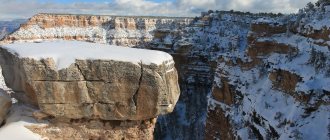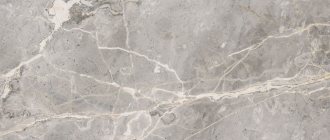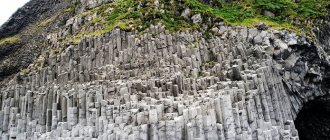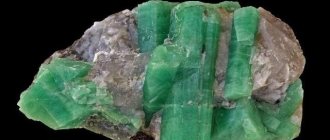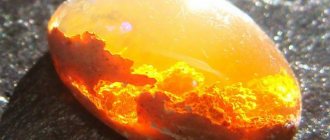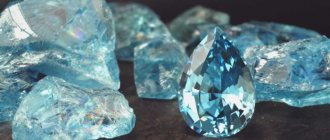The base of any steep cliff, no matter how monolithic it may look, is strewn with stones and rubble. This happens because any rock that comes to the surface of the Earth is destroyed over time, turning into an accumulation of debris. This process is called weathering , although it is not related to the activity of the wind. Weathering is the process of destruction of rocks under the influence of temperature changes, as well as chemical compounds contained in water and air, or as a result of the activity of living organisms. Depending on which of these factors predominates, three types of weathering are distinguished: physical, chemical and biogenic, but very often they all act together, complementing each other.
Types of stones
Diamonds
All stones can be divided into three large groups. The first group includes precious stones. They are used in making jewelry. These are diamond, sapphire, ruby. Such stones are beautiful and rarely found in nature. It is important to note that gemstones can also be used in industry. For example, diamond is used as a cutting material, because it is the hardest substance in nature.
Quartz
The second group is semi-precious stones. They are much cheaper than precious ones, but are also used in the manufacture of luxury goods. These include crystal and quartz. Chandeliers, dishes and other interior items are made from crystal.
Marble Quarry
The most common stones are included in the third group - ornamental stones. They are used in everyday life, primarily in construction. Examples of such stones are granite and marble.
How rocks are destroyed
Stones are prone to destruction under the influence of external factors. These include:
- Temperature. On warm, sunny days, the stones heat up and cool down at night. As you know, when heated, solids expand, and when cooled, they contract. It is noteworthy that in different areas heating occurs with different intensities. As a result, expansion and contraction also occur unevenly. Gradually, cracks form in the stones and rocks, into which water enters. When it freezes, it begins to put pressure on the walls of the cracks with enormous force, literally bursting the rocks from the inside. Sooner or later they cannot stand it and break into smaller pieces.
Rice. 3. Cracks in the rocks.
- Wind. Strong gusts of wind blow smaller particles off the surface of the stones. During a strong storm, the wind carries a huge amount of small sand particles. Colliding with stones at high speed, they act like sandpaper, polishing and changing the shape of their surface.
With the wind, plant seeds can fall into the cracks of rocks and germinate directly in the rock. The growing roots gradually widen the cracks and break the stones.
At the foot of the cliffs you can always find scatterings of small stones. The impact of wind is the weakest factor, since the destruction of stone occurs over many hundreds and thousands of years.
- Water. After snow melts and heavy rains, powerful streams of water pick up stones and roll them over, carrying them over long distances. During their “travels,” the stones are ground against each other, crushed, gradually turning into clay and sand.
How does water wear away a stone?
Moving water can erode and destroy rocks. This process is called erosion (translated from Latin it means “corrosion”). Any river, both mountain and lowland, has the ability to erode. But the destructive power of mountain streams is especially great, since due to the large difference in altitude, they have a strong current and are capable of carrying not only silt and sand, but also stones, and this is precisely the abrasive material with which a mountain river “gnaws” a passage even in mountain ranges that slowly rise during the process of mountain building along the path of an already formed mountain stream.
Grand Canyon (Grand Canyon)
The most impressive gorge created by a mountain river is the Grand Canyon, which cuts through the Colorado Plateau in the southwestern United States. Its length is 515 km, and its width in some places reaches 30 km. About 60 million years ago, a plain, slightly elevated above sea level, separated the Walpay River, flowing from the Rocky Mountains, and the Colorado River basin. Century after century, the Hualpay River gnawed into a plain composed of loose layers of sedimentary rocks. The process of erosion caused the two rivers to merge to form the modern Colorado River. Over millions of years, the bottom of the canyon continued to deepen, and currently reaches a fantastic depth of 1600 m.
Can the wind destroy a mountain?
Yes, it can, but not on its own, but, like flowing water, using “available” means for this - grains of sand and small pebbles. The wind throws them against the rocks with force, and they knock out ever-expanding cells in the stones. Layers of rocks are removed as if with sandpaper, and the wind immediately picks up and carries away the resulting dust and sand. This process is called deflation (from the Latin word deflatio, which means “deflation”, “fluttering”), and is sometimes called wind erosion . This process is very slow, but the wind has millions of years left. Over such a period of time, the wind, acting together with weathering and flowing water, is capable of erasing individual rocks and entire mountain ranges into sand.
Mountains are made of different rocks. Soft, loose rocks break down quickly, while hard rocks break down more slowly. Therefore, in place of destroyed mountains, relief forms may remain, which are called pillars , but these pillars may look in the most bizarre way. Such pillars are typical of many deserts, where wind and sand dominate. In the hottest region of China, in the Turfan Basin, there is a valley where sandstorms have carved bizarre sculptures from the rocks, and the wind, wandering between them, fills the surroundings with strange sounds. Local residents attributed these sounds to the evil spirits of the desert, which is why they called the valley the Valley of Demons.
Share link
What is chemical weathering?
Chemical weathering occurs when the minerals that make up a rock interact with substances in the air or water. In this case, various chemical transformations occur. Chemical weathering is especially intense in hot and humid climates, under a dense canopy of vegetation, since the decomposition of plant residues produces a lot of carbon dioxide and organic acids. In cold climates, chemical weathering does not play a special role due to low temperatures, which slow down the rate of chemical reactions.
Tags
destroying the stone from the inside. such a stone and Stone can year water in under water hidden under water hidden rocks in rock natural high temperature and temperature changes.
temperaturequestion mountainice personclassyearcanweatheringchemicalreasonbackmaterialarticlesdescriptionofcommentsloginfreezingincreasinglylanguageeducationevensitesonelessongiveorregistrationtestssearocksnaturalactionwithliquidmineralcoursesphenomenasaltnamepasswordsunyourworkknowledgemountainlimestonephototeachercoldnews
Breaking stones
Stones seem to be very strong and solid bodies. However, even they are gradually being destroyed. The easiest way to crush a stone is to hit it hard or drop it from a height. But in nature there are several other reasons that cause the destruction of stones.
First of all, these are temperature fluctuations. It is known that many substances, including stones, expand when heated and contract when cooled. At the same time, the stones warm up unevenly in the sun - the sunny side is stronger. As a result, one part of the stone expands and tries to expand another part of the stone that is not heated. This process can lead to the formation of very small cracks - microcracks. If a stone has cooled and heated up many times, then the cracks grow strongly and gradually destroy the stone.
If a stone is located near water (on the banks of a river or sea) and is constantly rolled around by waves, then it will change shape. Many people have noticed that the stones on the beaches are smooth and even. This is a consequence of the influence of water - it destroys the stone, and various protrusions are destroyed faster. You could say that water literally polishes the stone.
Sometimes water and temperature work together. If water gets into a crack in a stone, it will turn into ice at low temperatures. It is known that when water freezes, it expands, that is, the ice will begin to put pressure on the walls of the crack and will expand it.
Destroys stones and wind. It acts almost the same as water, however, since air is much lighter than water, the destruction process is longer. If there are a lot of dust particles in the air, it destroys the stone faster.
general information
Most changes in the surrounding landscape are not immediately noticeable. The process of destruction in natural conditions occurs very slowly, but it certainly exists. What happens in nature! The processes are the most amazing and varied, some of which are inexplicable.
In nature, over time, literally everything collapses, including stones, which seem to be such strongholds. As a result, everything turns into a completely different state and into other forms.
How can living organisms destroy rock?
Lichens that settle on bare rocks break down the rocks and introduce organic compounds, preparing the soil in which plant seeds can grow. That is why lichens are called pioneers in the development of living spaces.
Rocks are especially persistent in destroying plant roots, which penetrate into the smallest cracks and expand them as they grow. In various plant species adapted to life among rocks, the tips of their roots secrete organic acids that dissolve rocks. These acids are also produced by species of mosses and lichens that settle on stones. The participation of bacteria, unicellular algae, and lower fungi in biogenic weathering is very high. Animals also take a strong part in it - mollusks that drill holes in coastal rocks, rodents that make underground burrows and throw stones to the surface.
Why and under what conditions can stones collapse?
The destruction of stones is a long process that continues for millions of years. It occurs under the influence of the environment, and the more aggressive it is, the faster the transformation of the rock occurs. The process of destruction of rocks and minerals in nature is called weathering. Why do seemingly eternal rocks collapse? The main cause of weathering is a combination of physical, chemical and biological phenomena.
Exposure to atmospheric phenomena
What causes changes in the earth's crust and rocks? Rocks are affected by atmospheric phenomena such as winds, humidity fluctuations, precipitation, and temperature changes. The rocks that suffer most from weathering are those that are located in regions with large temperature differences, such as deserts. When heated during the daytime, the stones expand. At night, when the temperature drops by 20, and in some regions by 30 degrees, the body cools and contracts sharply. All this leads to the formation of cracks.
Water gets into the cracks of the stones. Unlike other substances, when it freezes it does not decrease, but, on the contrary, expands by a tenth of its original volume. Thus, frozen ice particles push the stone from the inside, and sooner or later it breaks.
If a block of stone is constantly exposed to water (for example, when the rock is located near the sea or river), then it gradually wears away. Gravity, wind, rainfall, mudflows, and earthquakes also play a significant role in the destruction of rock.
Chemical weathering is the destruction of stones that occurs as a result of chemical processes. The main factors of chemical weathering in nature are:
- water is a solvent and leads to hydrolysis or hydration;
- carbon dioxide – forms carbonates;
- oxygen – oxidizes minerals.
Influence of biological organisms
Another weathering factor in nature is the impact of biological organisms on rocks. Cracks in rocks often contain plant seeds that germinate inside the rock. Typically, grasses, shrubs and trees that grow in the mountains have a small root system, but as the plant grows, so do its roots. Over time, the cracks become deeper and wider, leading to the destruction of the stone.
Microorganisms play a significant role in biogenic weathering. In the process of life, they produce metabolites - chemical compounds that affect the structure of stones and minerals. Gradually, one rock is transformed into another or destroyed.
Human activity
The environment is greatly influenced by human activities. Mining or laying mines changes the surface of the earth's crust. This activity has especially increased since the 20th century, when modern drilling rigs appeared.
Currently, environmentalists have raised a real alarm, since changes in the landscape are leading to disruption of the ecological system. In response to such human activity, there is a risk of extinction of entire species of flora and fauna.
In order to convey the current situation to the population, workers studying this area are given assignments to write reports on this topic. They include slides with different interesting pictures. The presentation is held online. You can also listen to it in recording.
However, when telling such a story, one should depict the situation truthfully. Humanity is not only engaged in the destruction of mountains, but also creates waste heaps - dumps from processed rocks. Then the area is reclaimed and trees are planted in this place. A few years later, a hill with a forest growing on it already rises here. Externally, such an artificial planting does not differ from natural nature.
Impact on environmental stones
How are rocks destroyed in nature?
- On warm sunny days the stones heat up, and at night they cool down. Accordingly, they periodically expand and contract. Moreover, in some places the heating occurs strongly, in others - less. It turns out that both expansion and contraction are uneven. For these reasons, cracks appear in the stones, where water gets in, freezes in cold weather, and expands even more. The ice presses on the walls of the cracks with enormous force, and the stones split into smaller pieces, in which the same process is repeated. Under the influence of this factor, stone destruction most often occurs.
- How are rocks destroyed by wind? Wind, especially strong, can blow small particles from the surface of hard stones. During periods of strong storms, the wind carries with it a huge number of small particles of sand, which, hitting the stones, treat their surface like sandpaper. Also, plant seeds can get into the cracks and eventually grow right into them. The growing roots further widen the existing cracks and break the stones. After many hundreds and thousands of years, placers of smaller stones appear at the very foot of huge rocks. All this is the result of wind erosion. Wind exposure is the weakest factor influencing the destruction of stone.
- How are rocks destroyed by water? After rains and melting snow, and in rivers and rivers, streams of water pick up stones and roll them over, carrying them to different distances. The stones are ground together and on the ground and crushed. They can gradually turn into both clay and sand.
The difference between stones and metals
Not every solid object in nature is a rock. There are also metals. For example, pavements are made from stone (this is a type of covering for city streets), and sewer manholes are made from metals. But how are metals and stones different?
It turns out that metal can be melted (to do this it must be heated very much) and poured into some form. After cooling, we will get a new metal object, and the properties of the material will be preserved. This process is called casting and is used in industry to make parts. But stones cannot be cast. Some stones simply burn when heated, while others change their properties too much. Metals have many other distinctive properties that are studied in physics and chemistry lessons.
What is denudation?
On the plain, rock fragments accumulate where they were formed, protecting the underlying rocks from further destruction. But wherever there is a slope, and especially in the mountains, debris slides lower and lower down the slopes under the influence of gravity. This movement is facilitated by moving elements - water, wind, glaciers. The set of processes by which clastic material moves downward is called denudation (from the Latin word denudare, meaning “to expose”). Indeed, as a result of denudation, more and more layers of rocks are exposed and become accessible to weathering, and this greatly increases the rate of their destruction.
Blue Rocks
Blue Rocks is a geological outcrop in the Tomsk region on the right bank of the Tom River, 2 kilometers upstream from the mouth of the Basandaika River, part of the specially protected natural area “Coastal slope of the Tom River between the city of Tomsk, the village of Kolarovo and the Tomsk-Kolarovo highway” .
Other names for the outcrop are “Devil’s Finger” or “Anikinsky Blue Cliff”.
The cliffs consist of four adjacent sheer formations of shale outcrops on a steep slope of the river bank. The outcrop rock is formed by compressed silt that once settled to the bottom of the ancient sea that covered the West Siberian Lowland.
The height of the highest rock is approximately 50 meters. The rightmost rock, unlike the others, is not a rock at all, but rather a hill made of dense, strong clay, eroded by rain. This formation is popularly called the Devil's finger. A stream flows along the slope between the Devil's Finger and other rocks.
Devil's Finger is probably the only rock out of the four that even a child can climb without using any equipment. This is evidenced by traces of human presence in the form of marks and primitive images of clearly artificial origin.
Mountain hikers periodically conduct training on other rocks, which are stronger and steeper.
In the spring, when the river floods, the water reaches the very rocks, washing them away.
The level of water rise during floods is clearly visible in the illustration. In June, when the water is high, the foot of the rocks is one of the few places near the mouth of the Basandaika that is convenient for relaxing and swimming. Later, the water recedes by about 100-200 meters, exposing the rocky shore. At low water, immediately in front of the rocks and downstream almost to Basandaika itself, the bank is swampy and marshy, but 100 meters upstream and further the bank is rocky, durable, convenient for both fishing and swimming.
When the water is low, there is a dirt road in front of the rocks.
You can drive along it from Anikino to Zyryanovsky Island, which lies upstream, 2.5 kilometers from the rocks. On foot you can go to the foot of the rocks along a path descending from the steep Anikinskaya Mountain. The descent to the river lies 500 meters south of the rocks. From the place where the trail descends to Anikino it is no more than 2 kilometers.
By decision of the regional executive committee on December 22, 1986 No. 291, the geological outcrop at the mouth of the Basandaika River was declared a natural monument.

